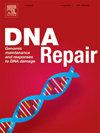The B cell dilemma: Diversity or fidelity?
IF 2.7
3区 生物学
Q2 GENETICS & HEREDITY
引用次数: 0
Abstract
The ability of B lymphocytes to diversify immunoglobulin (Ig) genes is central to the generation of high-affinity, class-switched antibodies and the establishment of effective humoral immunity. This diversification is achieved through three DNA remodeling processes that occur at defined stages of B cell development and maturation: V(D)J recombination, somatic hypermutation (SHM), and class switch recombination (CSR). These reactions all rely on the induction of programmed DNA lesions at Ig genes and their productive resolution by ubiquitous DNA repair pathways. However, such physiological sources of genotoxic stress render B cells vulnerable to genome instability, including mutations and chromosomal translocations that drive malignancies. Therefore, B cells have evolved complex regulatory networks that ensure efficient Ig gene diversification while minimizing the risk of unproductive or deleterious repair outcomes. In this review, we integrate foundational studies with recent mechanistic advances to outline how B cells exploit, coordinate, and constrain DNA repair to balance immune receptor diversification with the preservation of genome integrity.
B细胞的困境:多样性还是保真性?
B淋巴细胞使免疫球蛋白(Ig)基因多样化的能力对于产生高亲和力、类转换抗体和建立有效的体液免疫至关重要。这种多样化是通过发生在B细胞发育和成熟的特定阶段的三个DNA重塑过程实现的:V(D)J重组、体细胞超突变(SHM)和类开关重组(CSR)。这些反应都依赖于Ig基因的程序性DNA损伤的诱导,以及它们通过普遍存在的DNA修复途径的有效解决。然而,这种基因毒性应激的生理来源使B细胞易受基因组不稳定的影响,包括导致恶性肿瘤的突变和染色体易位。因此,B细胞进化出了复杂的调控网络,以确保高效的Ig基因多样化,同时最大限度地降低非生产性或有害修复结果的风险。在这篇综述中,我们整合了基础研究和最近的机制进展,概述了B细胞如何利用、协调和限制DNA修复来平衡免疫受体多样化和保持基因组完整性。
本文章由计算机程序翻译,如有差异,请以英文原文为准。
求助全文
约1分钟内获得全文
求助全文
来源期刊

DNA Repair
生物-毒理学
CiteScore
7.60
自引率
5.30%
发文量
91
审稿时长
59 days
期刊介绍:
DNA Repair provides a forum for the comprehensive coverage of DNA repair and cellular responses to DNA damage. The journal publishes original observations on genetic, cellular, biochemical, structural and molecular aspects of DNA repair, mutagenesis, cell cycle regulation, apoptosis and other biological responses in cells exposed to genomic insult, as well as their relationship to human disease.
DNA Repair publishes full-length research articles, brief reports on research, and reviews. The journal welcomes articles describing databases, methods and new technologies supporting research on DNA repair and responses to DNA damage. Letters to the Editor, hot topics and classics in DNA repair, historical reflections, book reviews and meeting reports also will be considered for publication.
 求助内容:
求助内容: 应助结果提醒方式:
应助结果提醒方式:


